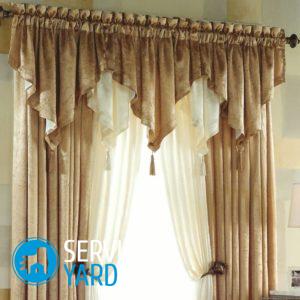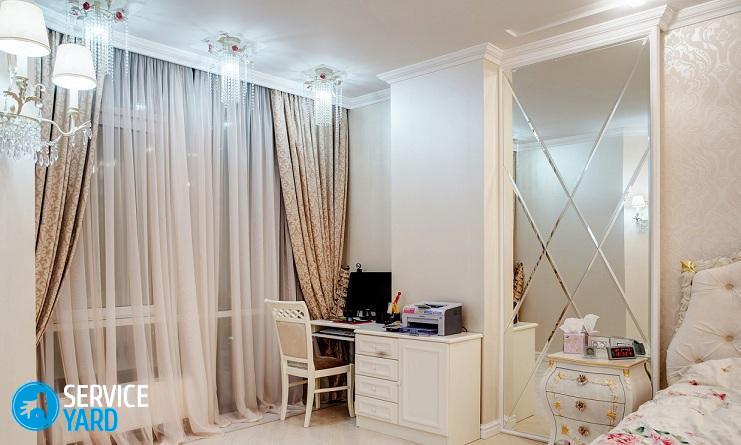How to sew a tulle?

The most familiar design for window opening today is tulle. Above the balcony, in the kitchen, in the bedroom, in the living room, above any door, such a curtain is in perfect harmony with the space. Despite the wide range on the market, the characteristics of these products do not always fully meet the needs of customers. But from this situation, you can find a way out - to make the curtain yourself. Today you will learn how to choose a fabric and how to sew a tulle at home.
to contents ↑How to choose the right material for sewing tulle?
It is quite natural that before you sew the tulle with your own hands, you need to decide on the most suitable fabric. It is important that it corresponds to the type of room for which the curtain is made - bedroom, living room, kitchen. It may be something more ambitious or more decorative, or it may be a practical option.
Today, most often for sewing tulle use the following materials:
- Kisei is a thread or rope fabric.
- Veil is a soft material, moderately transparent, but not too shiny.
- Organza is a transparent fabric with a tight weave of threads and a soft sheen.
- Grid - small, medium or large, with an interweaving of silver, colored or metallized threads.
The shape of the tulle can also be different:
- Product on braid or curtain tape. To achieve gentle folds, just pull the threads of the tape or braid slightly.
- Model on the grommets. On top of such a curtain has an elegant beautiful shape, but when moving, its transparency remains at the same level.
- Tulle hinged. This is the classic, easiest option. The loops can be sewn, with Velcro or buttons. This option is ideal for dense fabrics.
- Products with a lambrequin. Such models are less common, since the lambrequins are quite massive.
How to sew a tulle for the kitchen with a balcony door?
In principle, this room does not need curtains, but if you want to originally cover the balcony door, then this option is ideal for you. The design of the curtain will be quite simple, but it will go well with the door.
For work you will need:
- Finished material.
- Sewing machine.
- Scissors.
- Threads.
- Needles.
- Tailoring meter.
- Metal ruler.
- Curtain tape.
Instructions for the manufacture of kitchen curtains:
- First of all, determine the width and length. It is necessary to measure first the width of the window opening, then add the sum of the distances on the sides of the opening. This figure should be multiplied by two. In this case, you will get light folds.
Important! Measurements are best done with a soft meter or a metal ruler. The length is measured as follows: measure the distance from the cornice to the floor, add 3 cm to the allowances.
- Lay out the fabric on the floor, measure and cut it. Trim the excess edges. Fold allowances, gently stitch it. It is important that the line is perfectly flat, otherwise, the originally conceived design may change.
- Stitch the curtain tape from the wrong side.
With such a curtain, your kitchen will become more comfortable, beautiful, original, family gatherings or everyday breakfast, lunch, dinner will be a pleasure.
to contents ↑How to sew a tulle on grommets with your own hands?
To make such a tulle with your own hands, you need to prepare all the necessary tools and materials, perform initial work by analogy with the previous version, that is, everything related to measurements.
Next, proceed as follows:
- In this case, you do not need to do a pattern if you want to make straight curtains. Dimensions are applied to the fabric.
Important! If it is too thin, then large seam allowances should be made.
- Duplicate the top edge of the material on the grommets with adhesive cloth.
Important! You can use ordinary non-woven. It is easily glued on the wrong side with an iron.
- Then fold the allowances on the sides in half, turning inside out. Sweep the edges, then iron.
- Sew the top edge in the same way. After you sew the stitch, lay the fabric on the floor.
- Marking eyelets. Place the upper half of the fasteners on the curtain so that the center of the hole coincides with the mark. Circle the inner and outer diameter of the ring.
- Scissor out the inner circle.
- Insert the sleeve from the wrong side, cover it with the outer part, thread the edge of the fabric and thread inside the ring. Then squeeze the halves until they click. Do the same with other grommets.
- Pass the eaves rod through the rings, put the curtain in place.
to contents ↑Important! This is not the best option for the kitchen, since such a curtain would look too heavy over the balcony door. It is ideal to hang it above a free doorway or window.
How to sew a curtain on loops on your own?
Hinge curtain models are able to decorate the interior with their presence and elegantly complement it. In this section, we will describe in detail how to sew a tulle with your own hands. The master class will allow you to do everything easily and greatly simplify the task.
Necessary tools and materials:
- Suitable material.
- Lining fabric with adhesive backing.
- Threads.
- Scissors.
- Tape measure.
- Safety pins.
The progress is as follows:
- Install a curtain rail over the window opening. Step back from the opening 8 cm, go down from the cornice by 3 cm, measure the necessary length of the future product. Add to this figure 12 cm for the processing of the edges and 10 cm for the grinding of the upper edge of the curtain at the place of sewing the loops.
Important! To determine the width of the canvas, measure the width of the window, multiply it by 1.5.
- Cutting out. To cut the cloth and the edge, cut for each of them a strip of fabric 10 cm wide and a length equal to the width of the curtain. For each strip, cut out a strip of adhesive cloth that is 8 cm wide and equal in length to the curtain.
- Making loops. Outwardly, they look like wide stripes, which are then sewn to the upper edge of the tulle. Cut a rectangle of 20 cm long and 12 cm wide from the fabric. Fold the resulting element in half in length. On a typewriter, sew it near the outer edge, twist the resulting strip, manually sew the ends on the front side.
Important! Do the same steps as many times as you need loops.
- From the sides, bend on the sheets 1 cm in the direction to the wrong side. Additionally, fold 2 cm of fabric to form a kind of pocket that should be ironed. Sew each inner hem.
- Fold the bottom edge to the inside 2.5 cm, then another 7.5 cm. Iron the bottom well to form the corners of the fabric. Turn them to the inside of the fold so that a diagonal forms between the fold from the bottom and the side. Sew the resulting hem from the bottom. Sew corner stitches with hidden stitches.
- Face the curtain and pin ready-made hinges to it, doubled at both ends. Carefully measure the distance between the loops. Insert the loops into the stitched pocket, sew it around the edge. Sew a pocket from the bottom edge.
- Iron the resulting curtain, make sure that no threads stick out anywhere.
Stock footage
If you carefully follow the instructions, you can easily sew a tulle of any type, for any room in the house, decorate it at your discretion, give the desired shape. Even a beginner who can evenly line a line will cope with such work.
- How to choose a vacuum cleaner taking into account the characteristics of the house and coatings?
- What to look for when choosing a water delivery
- How to quickly create comfort at home - tips for housewives
- How to choose the perfect TV - useful tips
- What to look for when choosing blinds
- What should be running shoes?
- What useful things can you buy in a hardware store
- Iphone 11 pro max review
- Than iPhone is better than Android smartphones




